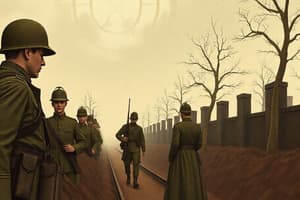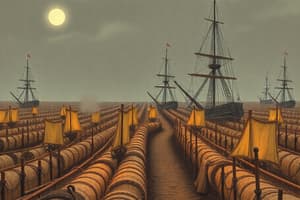Podcast
Questions and Answers
What type of warfare primarily characterized the Western Front during World War I?
What type of warfare primarily characterized the Western Front during World War I?
- Trench warfare (correct)
- Guerrilla warfare
- Naval warfare
- Mobile warfare
Which battle was NOT fought on the Western Front?
Which battle was NOT fought on the Western Front?
- Battle of Tannenberg (correct)
- Battle of the Marne
- Battle of Verdun
- Battle of the Somme
Which innovation was crucial for trench warfare during World War I?
Which innovation was crucial for trench warfare during World War I?
- Submarines
- Biplanes
- Battleships
- Flamethrowers (correct)
What was one of the main characteristics of fighting on the Eastern Front?
What was one of the main characteristics of fighting on the Eastern Front?
Which weapon was NOT an important development during World War I?
Which weapon was NOT an important development during World War I?
Which of the following statements about the trenches is true?
Which of the following statements about the trenches is true?
What role did submarines play during World War I?
What role did submarines play during World War I?
Which of the following best describes the levels of death and destruction in World War I?
Which of the following best describes the levels of death and destruction in World War I?
Which statement best contrasts the Western and Eastern Fronts?
Which statement best contrasts the Western and Eastern Fronts?
Flashcards
Western Front
Western Front
The main battleground in Western Europe during World War I, stretching from the North Sea to the Swiss border, where Germany battled France, Britain, and the United States.
Eastern Front
Eastern Front
The Eastern Front was the battleground in Eastern Europe, including present-day Poland, Ukraine, and Russia, where Germany and Austria-Hungary fought Russia and later Romania.
Trench Warfare
Trench Warfare
A type of warfare that emerged in World War I, where soldiers dug deep trenches for protection, leading to stalemates and massive battles.
Battle of the Somme
Battle of the Somme
Signup and view all the flashcards
Battle of Verdun
Battle of Verdun
Signup and view all the flashcards
Battle of Tannenberg
Battle of Tannenberg
Signup and view all the flashcards
Brusilov Offensive
Brusilov Offensive
Signup and view all the flashcards
Modern Warfare
Modern Warfare
Signup and view all the flashcards
Machine Gun
Machine Gun
Signup and view all the flashcards
Trenches
Trenches
Signup and view all the flashcards
Study Notes
Fronts of War
-
Western Front: Primarily in Western Europe, from the North Sea to the Swiss border. Key countries involved: Germany, France, UK, and later USA. Trench warfare was prevalent, characterized by prolonged stalemate. Large-scale battles like the Battle of the Somme and Verdun occurred.
-
Eastern Front: Eastern Europe, including present-day Poland, Ukraine, and Russia. Key countries were Germany, Austria-Hungary, and Russia (later Romania). Compared to the Western Front, combat was more mobile and involved large territorial changes. Significant battles on this front included Tannenberg and the Brusilov Offensive.
How WWI Was Fought
- Industrialization: European industrialization created a new scale of warfare, using both existing and new technologies to inflict massive damage in soldiers and civilians.
- Massive Death and Destruction: WWI saw widespread death and destruction caused by new technologies and strategies.
New or Improved Innovations of War
- Trench Warfare: Reshaped war, necessitated new strategies and tools
- Specialized Tools: Trench mortars, flamethrowers, grenades were used for navigating entrenched enemy positions.
- Artillery Advances: More powerful and accurate guns revolutionized the battlefield.
- Machine Guns: Rapid and continuous fire was a pivotal advantage
- Chemical Warfare: Poison gas was introduced, requiring gas masks to defend against it.
- Tanks: Revolutionized ground warfare, with mobile armored protection and firepower.
- Airplanes: Key players in aerial warfare, including dogfights and reconnaissance.
- Submarines: Especially German U-boats, emerged as important naval weapons.
- Communication Technology: Telephones and radios improved coordination.
- Barbed Wire: A significant obstacle in trench warfare.
The Trenches
- Description: One of WWI's defining characteristics; long, narrow ditches dug into the ground for soldiers to live and fight. Typically about 6 feet deep and wide, using packed earth or wood walls for protection for soldiers from enemy fire.
- Organization: Series of trenches: Front Line (or trench line), Reserve trenches, Support trenches, situated to support the front lines if an attack occurred.
- Stalemate: Characterized by a stalemate, repeated attempts by both sides to break through the enemy's trench line.
- New Deadly Weapons: Trench warfare used new weapons such as poison gas and machine guns.
Studying That Suits You
Use AI to generate personalized quizzes and flashcards to suit your learning preferences.




